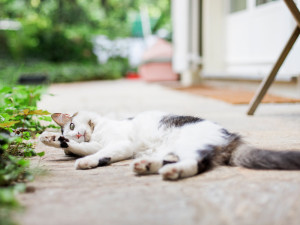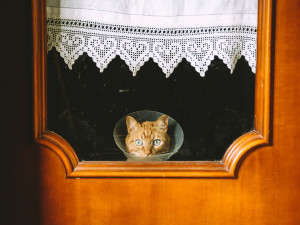What to Know About Fungal Skin Infections in Cats
Itchy and definitely not fun — here’s what to look out for.

share article

Your pet wants you to read our newsletter. (Then give them a treat.)
Healthy cats take great pride in their coats, grooming until every hair is shiny and slicked into place, like a kitty Bella Hadid (maybe the one celebrity who wasn’t in that terrifying live-action Cats movie.) Sometimes a blemish appears and disrupts that sleek silhouette. Fungal skin diseases are an important cause of skin problems in cats, and some can even be transmitted to people. Differentiating gross fungal skin lesions from other gross skin lesions can be challenging, but it’s always best to know what to look out for.
Fungi that cause skin infections in cats can come from other cats, the soil, or the yeast that are part of their skin’s normal flora. A cat’s breed, region of the country, local environment, and immune status will affect which fungi can cause problems for them.
What are some common causes of fungal skin infections in cats?
Ringworm
Despite its name, ringworm is not caused by a worm at all. In cats, it is caused by one of a few different fungi. The most common agents are Microsporum canis, Microsporum gypseum, and Trichophyton mentagrophytes. Ringworm is usually transferred directly from one infected animal or person to another through contact with an open lesion, though contact with contaminated soil or bedding can also cause an infection.
Ringworm lesions develop one to three weeks after exposure and usually appear as crusted, scaly, reddened, hairless areas. They are often circular and surrounded by broken, brittle hair. Early lesions commonly develop around the face, then spread to the paws and the rest of the body. Most animals seem to find them pretty itchy. Persian cats may develop nodules beneath their skin instead of the usual flat spots.
The most common way to diagnose ringworm is through a fungal culture. The sample is collected by brushing the cat’s hair (often with a brand-new toothbrush) before applying the brush to a fungal growth medium.
Some of the fungi that cause ringworm will fluoresce under black light. While this is a neat screening test, it doesn’t rule out or diagnose ringworm definitively because there are a lot of things that can cause false positives or false negatives.
In otherwise healthy animals, ringworm will usually go away on its own over time, but treatment is recommended to speed resolution because it is contagious to humans and other animals. Nine out of ten veterinarians recommend against showing up to a date with a fungal infection from your cat. Treating ringworm in cats ideally combines a topical agent like an anti-fungal dip or shampoo with an oral antifungal.
Environmental decontamination can reduce the spread of this disease and help to prevent reinfection. Remove all visible hair and skin flakes by vacuuming and brushing surfaces. Depending on the home environment, it might be best to steam-clean furniture and carpets. Clothes and other washable materials can be washed with a dilute bleach solution,per these CDC instructionsopens in a new tab.
Fungi grow slowly and die slowly. Treatment takes weeks to months to fully resolve almost any fungal infection, including ringworm.
Malassezia dermatitis
Malassezia are a normal part of the microbiome of a cat’s skin. These yeast organisms can sometimes overgrow and cause itchy, flaky skin. This is often accompanied by a greasy, reddish-brown discharge or discoloration of the skin.
This type of overgrowth can be seen in cats who have compromised immune systems, such as those with feline immunodeficiency virus, feline leukemia virus, diabetes mellitus, cancer, or other health issues. Hairless cat breeds, including the Sphynx and Devon Rex, may be predisposed to a generalized dermatitis, while very hairy cat breeds, such as Persians and Himalayans, tend to get yeast dermatitis in their facial folds.
Malassezia dermatitis is treated with topical therapies because the yeast live on the surface of the skin. For generalized conditions, a topical shampoo is often needed. Some cats with very localized problems respond well to spot treatment with medicated wipes.
What are some uncommon fungal skin infections in cats?
Outdoor cats get exposed to a wide variety of pathogens as they explore and hunt. Some of these environmental exposures include fungi that can cause weird diseases. Keeping your cat indoors is always safest, no matter how much they want to make friends with that bird on the patio.
Cryptococcosis
Cryptococcus species of fungi live in the soil. When cats stir up contaminated soil, they can inhale fungal spores and develop a systemic infection. This systemic infection can spread fungi throughout the body, resulting in soft to firm masses all over the body. The most obvious external sign of this disease is often a severely swollen, hairless, ulcerated tip of the nose.
Sporotrichosis
These fungi of the Sporothrix species cause solitary to multifocal nodules that are initially firm, but then soften and begin draining pus. In severe cases, the yeast form of this fungus may spread through the lymphatic system and cause systemic disease. Cats get this disease when their skin is punctured by something with contaminated soil on it. This is also called “rose gardener’s disease” in humans because the sharp thorns of roses are great at inoculating this fungus beneath the skin.
Blastomycosis
Like Cryptococcus and Sporothrix, Blastomyces organisms live in the soil. They cause a very severe systemic disease when cats inhale fungal spores. Cats infected with this fungus can develop skin lesions that range from small nodules to large abscesses. Blastomycosis is a very severe and life-threatening systemic disease that is fortunately uncommon in cats.
Can people get fungal diseases from cats?
People can get ringworm from direct contact with an infected cat. Cats infected with Sporothrix can also transfer it directly to humans through cat scratches; this is an ongoing problem in Brazil and may be spreadingopens in a new tab. Though humans are also affected by cryptococcosis and blastomycosis, the form that infected cats carry cannot be transmitted directly to people. Either way, it’s smart to practice good hygiene and wash your hands after handling any cat, especially one with skin lesions.

Dr. Bartley Harrison, DVM
Dr. Bartley Harrison, DVM is a small animal veterinarian based in North Carolina who has practiced emergency medicine since graduating from the Texas A&M College of Veterinary Medicine. His primary interest areas include pain management, cardiology, and the treatment of shock.
He is a member of the Veterinary Emergency and Critical Care Society, American Veterinary Medical Association, and American Medical Writers Association. In addition to his clinical work, he writes pet health articles to help provide accurate information for both new and experienced pet parents. When he’s not working, he enjoys cooking, traveling, reading, and going on adventures with his dog.
Related articles
![Cat playing and jumping with a rubber band]() opens in a new tab
opens in a new tabWhat’s the Deal with FIV in Cats?
The most common questions about feline immunodeficiency virus, answered. Good news: most cats live long, happy lives.
![Owner pets senior ginger cat.]() opens in a new tab
opens in a new tab6 Common Health Concerns in Senior Cats
How to spot and how to treat them.
![Unrecognizable woman petting an ill cat]() opens in a new tab
opens in a new tabNow, Something No One Wants to Talk About: Cat Cancer
Veterinarian Dr. Alycia Washington breaks down the four most common types of cancer in cats, from how to spot the early signs to how to treat them.
![Uncomfortable looking gray cat sitting on a window sill]() opens in a new tab
opens in a new tabShould Your Cat Go to the ER?
Here are six good reasons to haul tail to the emergency room.
![cat with cone after vet visit]() opens in a new tab
opens in a new tabDoctor’s Orders: Cat Vet Visits Are Essential
Get thy cat to a vet, even if it’s a struggle to get them out the door.
![cat getting a vaccine at the vet]() opens in a new tab
opens in a new tabYep, Kittens Need Vaccines (Even Indoor Ones)
A vet gets the facts straight.










